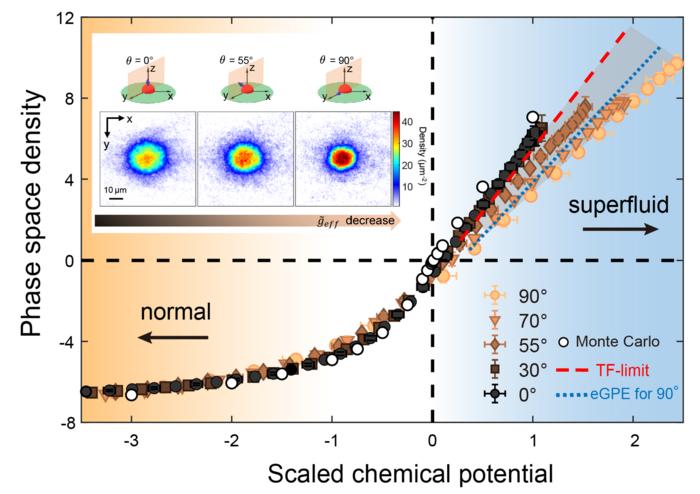
In a significant advancement in the realm of condensed matter physics, a dedicated international team, spearheaded by Professor Jo Gyu-Boong from the Department of Physics at the Hong Kong University of Science and Technology (HKUST), has made an extraordinary observation regarding the Berezinskii-Kosterlitz-Thouless (BKT) phase transition in a two-dimensional (2D) dipolar gas of ultracold atoms. This research represents an unprecedented milestone in our understanding of how 2D superfluids behave under long-range and anisotropic dipolar interactions.
The concept of phase transitions is foundational in physics, typically understood through the lens of symmetry breaking. In usual three-dimensional systems, such as water transitioning into ice, these phase changes are governed by the spontaneous breakdown of symmetry. However, theoretical predictions established in the 1970s brought forth the idea that two-dimensional systems could exhibit a distinctive kind of phase transition—the Berezinskii-Kosterlitz-Thouless transition. This transition stands apart because it is driven by vortex-antivortex pairs, which catalyze superfluidity without the usual mechanisms of symmetry breaking. This insight pivotally demonstrates how interaction dynamics play a crucial role in the state of matter.
The research team, led by Professor Jo, ventured into the relatively uncharted territory of 2D dipolar gases. Unlike traditional ultracold gases that mainly utilize contact interactions, dipolar interactions span the entirety of the system. This characteristic leads to some intriguingly rich collective phenomena that can vastly amplify our understanding of quantum behaviors in lower dimensions. By experimentally observing how dipolar interaction alters the critical parameters associated with the BKT transition, the researchers have shed light on these complex interactions.
Professor Jo expressed the revolutionary implications of dipolar interactions in quantum many-body systems, stating, “Dipolar interaction brings a new aspect to quantum many-body phenomena.” He elaborated that the directional and far-reaching nature of these interactions implies that even widely separated particles remain interconnected. Such a perspective challenges existing intuitions surrounding the emergence of order in low-dimensional systems, providing fresh avenues for exploration and understanding.
The graduate student HE Yifei, who played a significant role in the study as one of its leading authors, emphasized the potential of the 2D dipolar system as a long-sought experimental platform for observing exotic phases. Yifei noted that the observed phenomena, including unique non-local effects and anisotropic density-density correlation in the 2D dipolar superfluid—especially when aligning dipoles within the same plane—even at moderate interaction levels, hint at unexplored dynamics that could be revealed by further increasing the dipole strength.
The BKT transition is pivotal as it outlines a framework for understanding superfluidity in lower dimensions. The implications of such a framework are not only vast within the field of condensed matter physics but also extend to applications in areas such as quantum computing and materials science. As researchers deepen their probing into the dynamics of 2D systems, the potential to unveil more about the symmetries and interactions at play could pave the way for novel materials with tunable properties and enhanced functionalities.
The experiments demonstrated by the research team raised crucial questions concerning the relationship between dipolar interactions and the BKT transition’s critical parameters. In their findings, it was evident that the configuration and orientation of dipoles with respect to the direction of symmetry profoundly influenced the transition points. This shifting dynamic reaffirms the significance of strong, anisotropic interactions in low-dimensional systems, showcasing how experimental observations can lead to fresh theoretical insights.
As research in this domain continues, it is likely that the findings will stimulate further investigations into the generality of these behaviors across various systems. The capability of dipolar gases to offer a versatile platform for studying exotic phases of matter presents exciting possibilities. For physicists, this means new opportunities to explore the fundamental aspects of quantum mechanics, potentially altering the trajectory in which ultracold atom studies unfold.
The research also sets the stage for future experiments aimed at exploiting the rich physics encapsulated in 2D dipolar systems. By pushing the boundaries of dipolar strength, researchers can anticipate how the interplay between interactions and dimensionality leads to emergent phenomena probed in pure experimental terms. Each experiment offers further validation of the theoretical frameworks and opens new avenues of inquiry that could redefine existing paradigms within the field.
Ultimately, this remarkable research underscores the blending of theory with meticulous experimental practice. Moving forward, the implications of these findings beckon the scientific community to engage with this line of inquiry, bridging gaps across various sub-disciplines within physics. As the conversations flourish around ultra-cold dipolar gases and their unique interactions, the significance of this research will become increasingly relevant, emphasizing how fundamental research can shape our understanding of the universe.
The landscape of science is continually evolving, and studies like this one provide a critical lens through which the intricacies of quantum mechanics can be better understood. By advancing our comprehension of how matter behaves under specific conditions, the research marks a forward stride in the persistent quest for knowledge about the universe’s fundamental nature—a pursuit that will no doubt inspire forthcoming generations of physicists.
Subject of Research: Understanding the Berezinskii-Kosterlitz-Thouless transition in a two-dimensional dipolar gas of ultracold atoms
Article Title: Exploring the Berezinskii-Kosterlitz-Thouless transition in a two-dimensional dipolar bose gas
News Publication Date: 9-Apr-2025
Web References: 10.1126/sciadv.adr2715
References: Not applicable
Image Credits: Credit: HKUST
Keywords
Superfluidity, Quantum Mechanics, Two-Dimensional Systems, Dipolar Interactions, Berezinskii-Kosterlitz-Thouless Transition.
Tags: anisotropic interactions in superfluidsBerezinskii-Kosterlitz-Thouless phase transitioncondensed matter physics researchdipolar interactions in ultracold gasesHKUST physics research breakthroughslong-range interactions in quantum systemsphase transitions in physicsrole of interactions in quantum mattersuperfluidity in two-dimensional systemssymmetry breaking in two-dimensional systemsultracold atomic gasesvortex-antivortex pairs in superfluidity





